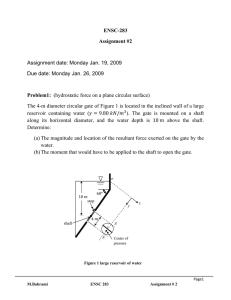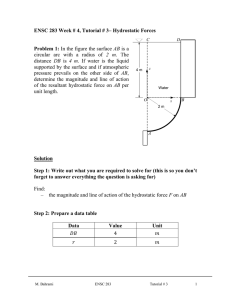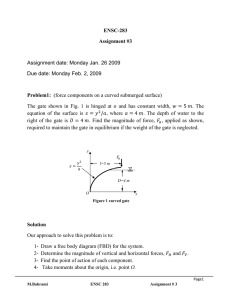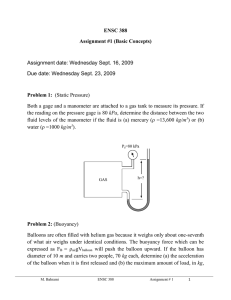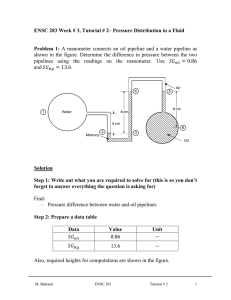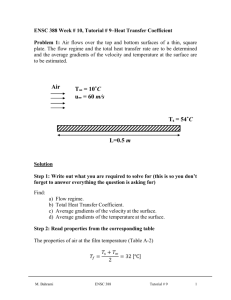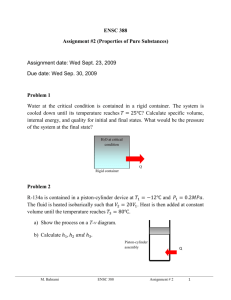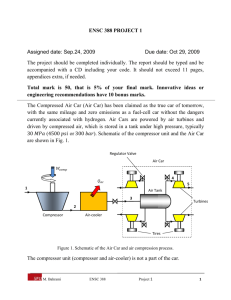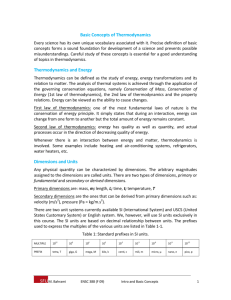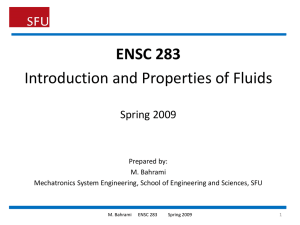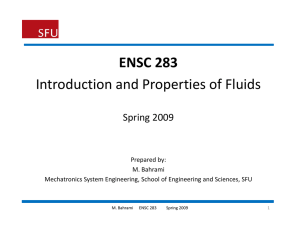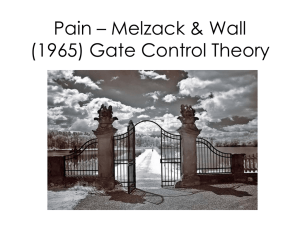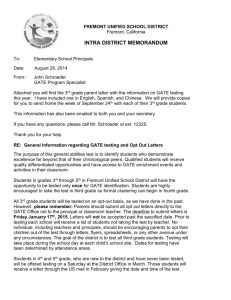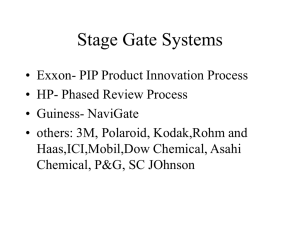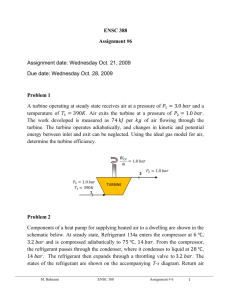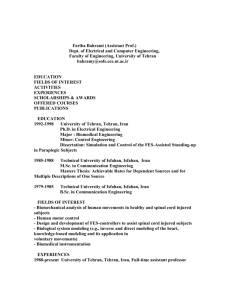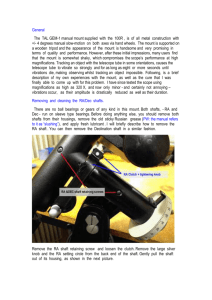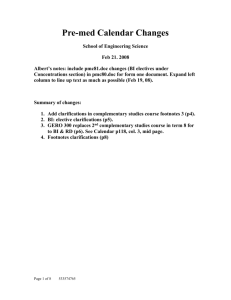Assignment2_solution
advertisement
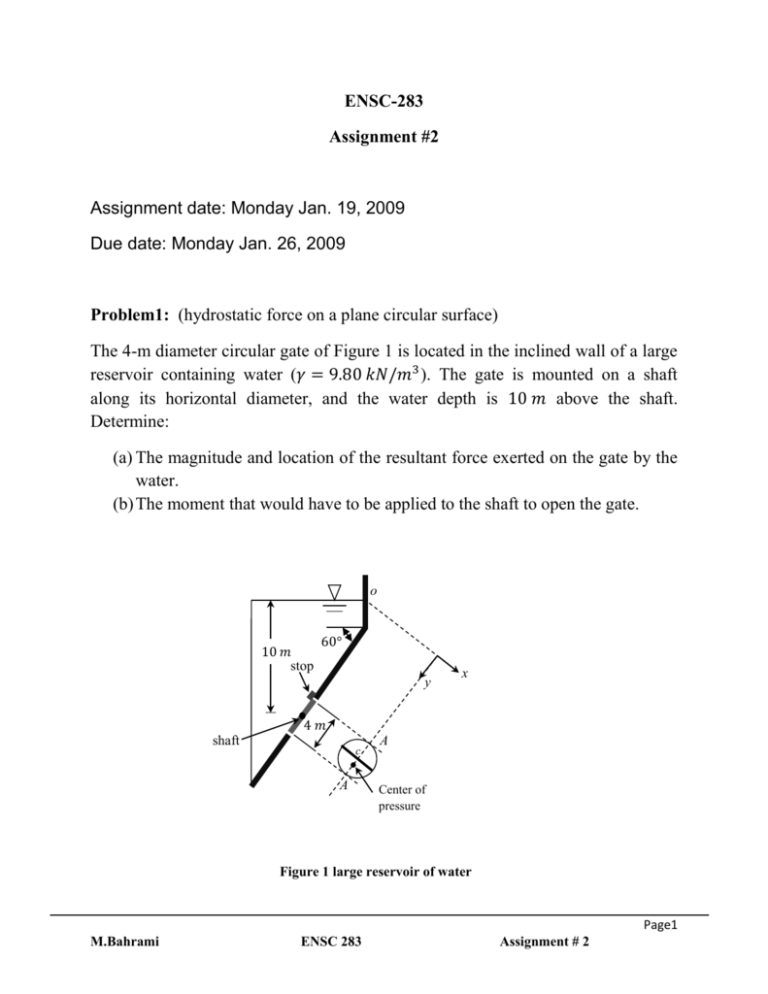
ENSC-283 Assignment #2 Assignment date: Monday Jan. 19, 2009 Due date: Monday Jan. 26, 2009 Problem1: (hydrostatic force on a plane circular surface) The 4-m diameter circular gate of Figure 1 is located in the inclined wall of a large reservoir containing water (𝛾 = 9.80 𝑘𝑁/𝑚3 ). The gate is mounted on a shaft along its horizontal diameter, and the water depth is 10 𝑚 above the shaft. Determine: (a) The magnitude and location of the resultant force exerted on the gate by the water. (b) The moment that would have to be applied to the shaft to open the gate. o 10 𝑚 stop 60° y x 4𝑚 shaft c A A Center of pressure Figure 1 large reservoir of water Page1 M.Bahrami ENSC 283 Assignment # 2 Solution (a) To find the magnitude of the force of the water we can use the following equation (1) 𝐹𝑅 = 𝛾ℎ𝑐 𝐴 and because the vertical distance from the fluid surface to the centroid of the area is 10 𝑚 it follows that 𝐹𝑅 = (9.81 × 103 [ 𝑁 ]) (10 [𝑚])(4𝜋 [𝑚2 ]) = 1.23 𝑀𝑁 𝑚3 To locate the point (center of pressure) through which 𝐹𝑅 acts, we use Eq. (2) and (3), 𝑥𝑅 = 𝐼𝑥𝑦𝑐 + 𝑥𝑐 𝑦𝑐 𝐴 (2) 𝑦𝑅 = 𝐼𝑥𝑐 + 𝑦𝑐 𝑦𝑐 𝐴 (3) o 10 𝑚 stop o 60° y c W (a) yc yR FR oy FR x 4𝑚 ox M shaft c A c A Center of pressure (b) 𝑦𝑐 = 10𝑚 𝑠𝑖𝑛60° (c) Figure 2 force diagram of the reservoir Page2 M.Bahrami ENSC 283 Assignment # 2 For the coordinate system shown, 𝑥𝑅 = 0 since the area is systematical, and the center of pressure must lie along the diameter 𝐴 − 𝐴. To obtain 𝑦𝑅 , we have from Fig. 2-13 of the text boSok, 𝜋𝑅 4 𝐼𝑥𝑐 = 4 and 𝑦𝑐 = 10/𝑠𝑖𝑛60° is shown in Fig. 2-c, thus, (4) (𝜋/4)(2 [𝑚])4 10 [𝑚] 𝑦𝑅 = + = 11.6 [𝑚] (10 [𝑚]/𝑠𝑖𝑛 60°)(4𝜋 [𝑚2 ]) 𝑠𝑖𝑛60° The distance (along the gate) below the shaft to the center of pressure is then 𝑦𝑅 − 𝑦𝑐 = 0.0866 [𝑚] Note: Pressure force is always perpendicular to the gate surface. (b) To calculate the moment required to open the gate, free body diagram shown in Fig. 2-a should be used. In this diagram, 𝑊 is the weight of the gate and 𝑂𝑥 and 𝑂𝑦 are the horizontal and vertical reactions of the shaft on the gate. Since static condition is established ∑ 𝑀𝑐 = 0 (5) And therefore, 𝑀 = 𝐹𝑅 (𝑦𝑅 − 𝑦𝑐 ) = (1230 × 103 [𝑁])(0.0866 [𝑚]) = 1.07 × 105 [𝑁. 𝑀] Page3 M.Bahrami ENSC 283 Assignment # 2 Problem2: (use of the pressure prism concept) A pressurized tank contains oil (𝑆𝐺 = 0.90) and has a square, 0.6 𝑚 × 0.6 𝑚 plate bolted to its inside, as illustrated in Figure 2. The pressure gage on the top of the tank reads 50 𝑘𝑃𝑎, and the outside of the tank is at atmospheric pressure. What is the magnitude and location of the resultant force on the attached plate? 𝑝 = 50 𝑘𝑃𝑎 Air Oil 2𝑚 0.6 𝑚 Figure 3 pressurized tank Solution The pressure distribution acting on the inside surface of the plate is shown in Fig. 3. The pressure at a given point on the plate is due the air pressure, 𝑝𝑠 , at the oil surface, and the pressure due the oil which varies linearly with depth as is shown in Fig. 4. The resultant force on the plate (𝐹𝑅 ) is due to the components, 𝐹1 and 𝐹2 , where 𝐹1 and 𝐹2 are due to the rectangular and triangular portions of the pressure distribution, respectively. Thus, Page4 M.Bahrami ENSC 283 Assignment # 2 𝐹1 = (𝑝𝑠 + 𝛾𝑜𝑖𝑙 ℎ1 )𝐴 𝑁 𝑁 = (50 × 103 [ 2 ] + 0.9 × 9.81 × 103 [ 3 ] × 2 [𝑚]) (0.36 [𝑚2 ]) 𝑚 𝑚 3 = 24.4 × 10 [𝑁] and ℎ2 − ℎ1 𝑁 0.6 [𝑚] ) 𝐴 = (0.9 × 9.81 × 103 [ 3 ]) ( ) (0.36 [𝑚2 ]) 2 𝑚 2 3 = 0.954 × 10 [𝑁] 𝐹2 = 𝛾𝑜𝑖𝑙 ( oil surface 𝛾ℎ1 𝑝𝑠 ℎ1 = 2 𝑚 ℎ2 = 2.6 𝑚 𝐹1 0.6 𝑚 𝐹𝑅 𝐹2 𝑦𝑜 0.3 𝑚 𝑜 0.2 𝑚 𝛾(ℎ2 − ℎ1 ) plate Figure 4 force diagram of the pressurized tank The magnitude of the resultant force, 𝐹𝑅 , is therefore, 𝐹𝑅 = 𝐹1 + 𝐹2 = 25.4 [𝑘𝑁] Page5 M.Bahrami ENSC 283 Assignment # 2 The vertical location of 𝐹𝑅 can be obtained by summing moments around an axis through point 𝑜. Thus, 𝐹𝑅 𝑦𝑜 = 𝐹1 (0.3 [𝑚]) + 𝐹2 (0.2 [𝑚]) 𝑦𝑜 = (24.4×103 [𝑁])(0.3 [𝑚])+(0.954×103 [𝑁])(0.2 [𝑚]) 24.4×103 [𝑁] = 0.296 [𝑚] Note: The air pressure used in the calculation of the force was gage pressure. Atmospheric pressure does not affect the resultant force, as it acts on both sides of the plate, therby canceling its effect. Page6 M.Bahrami ENSC 283 Assignment # 2
